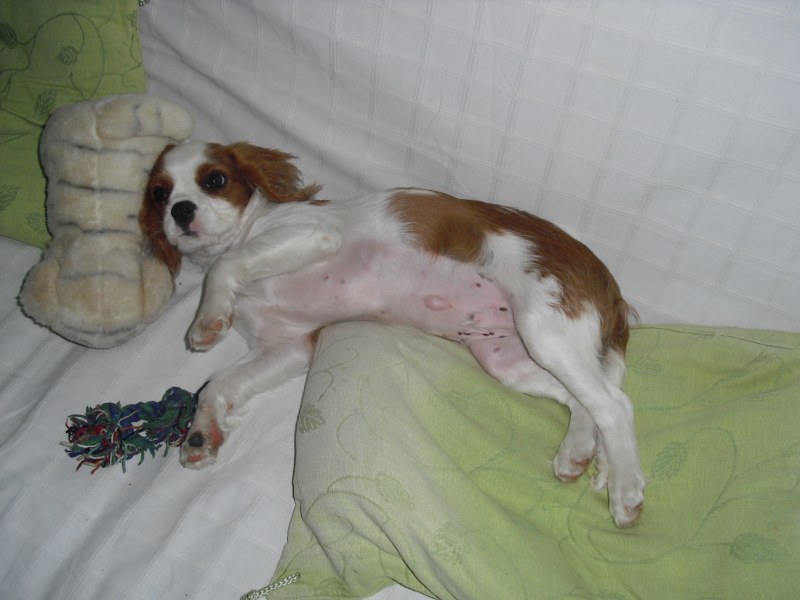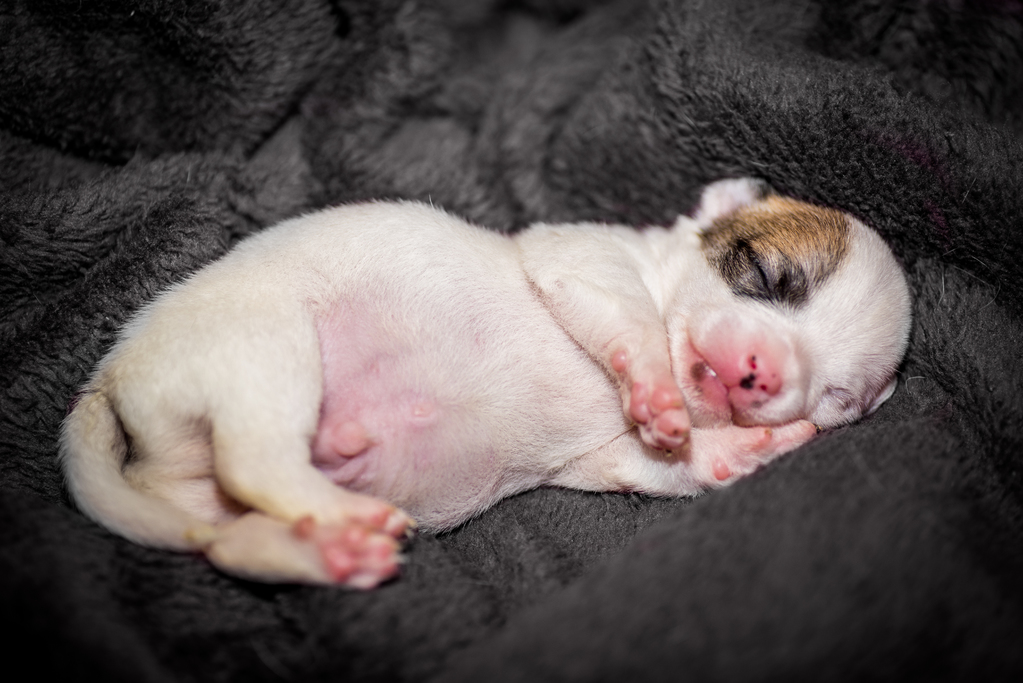Umbilical hernia in dogs
A dog's umbilical hernia occurs when an organ protrudes from its normal cavity, producing a smooth protrusion in the dog's belly button.
This phenomenon may worry owners, but it is usually not serious for the dog's health and only requires increased surveillance. In order to know everything about this phenomenon, I propose to look at its causes, its symptoms and its possible consequences on the dog's health.
What is umbilical hernia in dogs?
Umbilical hernia in dogs occurs when internal organs or tissues dislodge from their cavity and enter the umbilical area, i.e. the belly button. Different tissues or organs can be involved in an umbilical hernia. Most often, it is adipose tissue (fat), part of the peritoneum (membrane containing the intestines) or a portion of the intestines.
These pass through the scar of the umbilical cord and cross the muscular wall of the abdomen. They either remain under the skin, or they may leave the body completely, in which case it is called an omphalocele. Note that a hernia can affect different areas of the body. In addition to the umbilical hernia, this condition can occur in the groin (inguinal hernia), the anus and rectum (perineal hernia) and the abdomen or thorax (diaphragmatic hernia).
Some umbilical hernias are said to be reducible when they disappear with the help of pressure that pushes the organs back to their original location. Conversely, when the hernia remains protruding at all times, it is called irreducible.
Causes of umbilical hernia in dogs
There are two types of umbilical hernias: a congenital form, present from birth, and an acquired form, which is rarer. Congenital umbilical hernia is caused by a genetic malformation involving a poor closure of the umbilical cord.
When a puppy is born, the navel should normally close naturally after a few days, while the umbilical cord dries and falls off. In some puppies, there is a congenital malformation in the umbilical ring that interferes with this closure.
Some breeds are predisposed to the development of this disorder, including the Pekingese, Beagle, Basenji, Weimar Pointer and Pointer. Acquired umbilical hernias are more rare. Again, they are more common in puppies when improper handling is done at the time of birth.
An umbilical cord that is cut too short, either by the bitch or by a human, can prevent healing and lead to a hernia. The same is true if the cord was pulled forward at the time of birth. In the adult dog, an acquired umbilical hernia can occur following a trauma (fall, shock, accident...) having generated a strong pressure on the dog's abdomen. This last case is however very episodic.

Symptoms of umbilical hernia in dogs
An umbilical hernia is the appearance of a bulge in the dog's belly button, a subcutaneous bump, which may be larger or smaller. In case of omphalocele, the viscera of the puppy are visible. Usually, there are no other symptoms accompanying an umbilical hernia, as this condition usually does not cause any particular pain or discomfort in the dog.
The mass emerging from the dog's abdomen is often soft and mobile (reducible hernia), or sometimes hard and adherent (irreducible hernia). It is often not detected immediately in the newborn puppy, but rather from the first 15 days of life.
In some cases, the umbilical hernia evolves into a more serious form: the strangulated hernia. This phenomenon occurs when the umbilical opening is wide enough for a loop of intestine to slip through. The intestine is then at risk of being strangled, deprived of blood supply and oxygen. This is a true veterinary emergency: there is a risk of necrosis of the organ, which can ultimately lead to the death of the dog.
Symptoms of this disorder include shock, fever, severe pain with panting, shaking and/or analgesic postures, and deterioration of general condition (anorexia, depression, etc.). Gastrointestinal disorders may also occur, including vomiting and constipation or small amounts of watery diarrhea.
This set of symptoms corresponds to an acute abdominal syndrome, similar to that which can be observed in the case of other serious affections of the digestive tract (intestinal occlusion, perforation, torsion dilatation of the stomach...).
Treatment and prognosis of umbilical hernia in dogs
The treatment and prognosis for the dog depends on both the size of the umbilical hernia and the health of the animal at the time of diagnosis. In puppies, when the mass is small (less than one centimeter), it is usually not treated until the animal is 6 months old. By then, the hernia may indeed close by itself.
After 6 months, it is up to the owner to make a choice: a dog can live without problems with a small hernia, even if the risk of complication towards a strangulation of the intestine is never zero. A small and simple surgical operation can remedy the problem by closing the umbilical opening permanently, but this operation is not vital for the dog.
The operation, called kelotomy, is done under general anesthesia and can be done at the same time as another operation (tattooing, sterilization, etc.) to avoid having to put the animal to sleep several times. When the umbilical hernia is more important (more than two centimeters), the surgical intervention is inevitable.
The risk of strangulation of the intestine is major, and the operation must be performed as soon as possible - without it being an emergency that sends you running to the veterinary hospital in the middle of the night. If the intestine is already necrotic, the dog's prognosis is more guarded, and partial removal of the organ will often be necessary, when possible.
Also, if umbilical hernia occurs in an adult dog following a trauma, the prognosis of the animal depends on the other lesions that the accident may have caused. In most cases, umbilical hernia has an excellent prognosis when it has not become complicated.
In the event of a complication, everything depends on how quickly the dog is taken care of: the longer the intestine remains strangled, the greater the risk of necrosis and lifelong sequelae, which can potentially lead to the dog's death. Regardless of the severity of a dog's umbilical hernia, and whether you want to have your dog treated just for peace of mind or because the extent of the hernia leaves you no other choice, it should be noted that the only treatment available is surgery.

FAQ
My puppy has an umbilical hernia, is it serious?
Umbilical hernia is a common condition in puppies that is not systematically serious when it is small, i.e. when it measures less than one centimeter. Larger umbilical hernias (more than two centimeters) present a major risk of complications, and it is highly preferable to have your puppy operated on quickly to avoid serious health problems. In all cases, it is advisable to consult a veterinarian to get an opinion on the degree of severity of your puppy's umbilical hernia and to know the procedure to follow.
How to treat an umbilical hernia in dogs?
The only way to treat an umbilical hernia is surgically. It is a very simple operation that allows to close the umbilical opening through which the dog's organs are slipping. When it is not very important, it is possible to wait before having your dog's umbilical hernia treated, as it can resolve itself up to 6 months of age or be done at the same time as another operation (sterilization, tattooing, etc.).
Why does my puppy have a belly button lump?
A bump in a puppy's belly button is often an umbilical hernia, a displacement of organs through the opening of the belly button. This condition is not serious, but it can become complicated, especially when the bump is large. It is easily treated with a small surgical intervention.
My dog has an umbilical hernia, will he keep it all his life?
In young puppies, a small umbilical hernia may resolve itself, so it is necessary to wait until the animal is about 6 months old to know if this condition is permanent. In dogs over 6 months of age, the umbilical hernia is definitive. When it is small (less than a centimeter), it can either be left in place for the life of the dog or treated with a very simple surgery.
Larger umbilical hernias, on the other hand, must necessarily be treated surgically to avoid complications with a dramatic outcome for the dog. The umbilical hernia of the dog is not a serious pathology, but it can nevertheless become seriously complicated, especially when it is voluminous.
As a precautionary measure, it is advisable to have your dog treated by a veterinarian who will perform a minor surgery to avoid any risk for your dog's intestine.
In addition, it is advisable not to breed a dog with a congenital umbilical hernia so that it does not transmit this malformation to its puppies.

